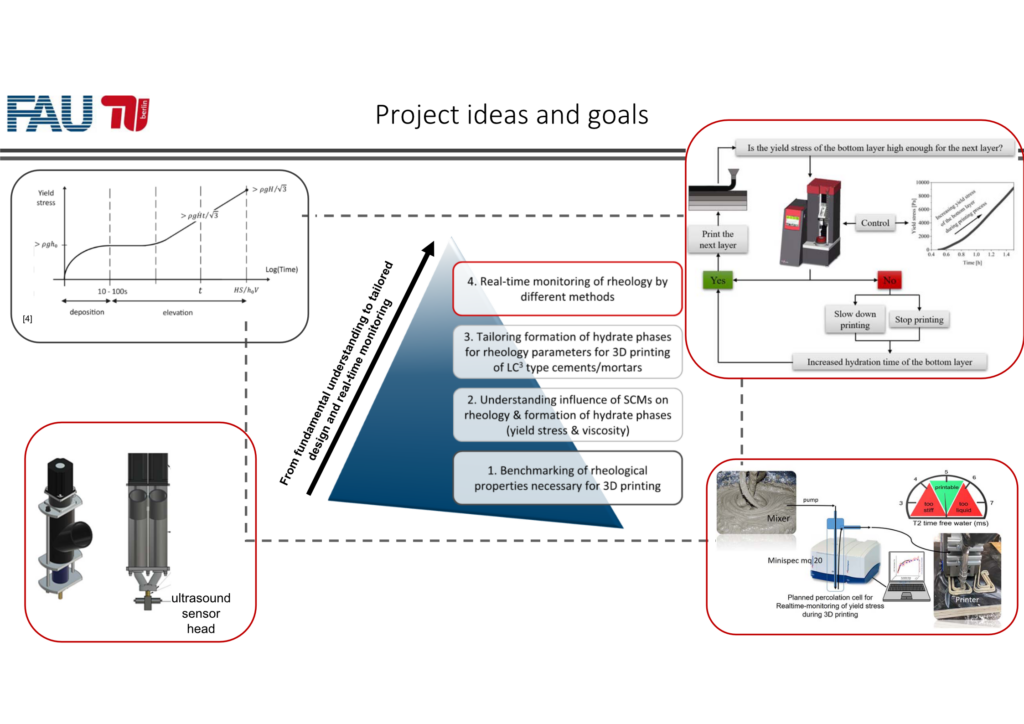24. Rheology of low clinker concretes with tailored superplasticizer polymers – Control and modelling of viscosity and thixotropic structural build-up
Principal investigator(s) – PI
- Dr. rer. nat. Daniel Jansen
Friedrich-Alexander Universität Erlangen-Nürnberg, GeoZentrum Nordbayern – Lehrstuhl für Mineralogie - Prof. Dr.-Ing. Dirk Lowke
TU Braunschweig, Institut für Baustoffe, Massivbau und Brandschutz (iBMB), Fachgebiet Baustoffe
Researcher(s) in-charge – RI
- M.Sc. David Nicia
TU Braunschweig, Institut für Baustoffe, Massivbau und Brandschutz (iBMB), Fachgebiet Baustoffe - M.Sc. Nicholas Fobbe
Friedrich-Alexander Universität Erlangen-Nürnberg, GeoZentrum Nordbayern – Lehrstuhl für Mineralogie
Researcher(s) associated – RA
- Prof. Dr. Jürgen Neubauer
Friedrich-Alexander Universität Erlangen-Nürnberg, GeoZentrum Nordbayern – Lehrstuhl für Mineralogie
Project Description
This project aims to understand and describe the decisive effects of the molecular structure of PCE superplasticizers on viscosity and thixotropic structural build-up of low clinker concretes (LCC) in order to derive rheological material laws to control technological processing in practice. The key element here is the explicit characterization of the particle microstructure in the binder suspension under quantitative consideration of both the colloidal interparticle interactions and the very early hydration kinetics.
Reducing the clinker content in cement and concrete is a promising way to reduce the CO2. Therefore, modern concretes are increasingly characterized by low clinker content and high content of supplementary cementitious materials (SCM) such as ground limestone, ground granu-lated blast-furnace slag or calcined clays. Given the high specific surface area of SCM, especially of calcined clays, on the one hand, and the increased requirements for modern concretes in terms of easy workability on the other, the addition of superplasticizers is essential.
Although some PCEs were found to effectively disperse particles in calcined clay blended cements, a high viscosity and respectively stickiness was observed. This is not a surprising fact, since the interaction of PCE in low clinker binder systems is poorly explored with respect to the PCE molecular parameters. Furthermore, boundary conditions regarding particle surface charge, ions in the liquid phase, solid content and particle size distribution differ significantly from OPC systems. Therefore, to control concrete fresh properties, a comprehensive understanding of the effect of PCE molecular structure on viscosity and thixotropy in low clinker binder systems with high amounts of SCM is important.
PCEs affect colloidal particle interactions as well as the very early cement hydration depending on their molecular structure. Therefore, in this research, tailored superplasticizers with varying side chain length, side chain density and backbone length will be investigated. Both, viscosity and the thixotropic structural build-up will be determined, not only on paste but also on mortar and concrete. This is an important step, as the upscaling can significantly change the behaviour of plasticized cementitious materials.
Additionally, the colloidal interparticle interactions, hydration kinetics as well as the particle microstructure will be quantified. Based on FBRM-coupled rheology to determine the in-situ agglomerate size, a microstructural model for viscosity and the thixotropic structural build-up at rest will be developed. The novelty of this model is that it specifically captures the particle microstructure of the binder suspension, thus bridging the gap between effects at the nano scale (PCE molecular parameters, colloidal interactions, hydration) and the macro scale (rheological properties). To obtain a correct description of the low clinker binder suspensions, a minimum number of parameters with a clear physical significance based on experimental investigations will be used as input parameters for the microstructural rheology model. To exploit the full potential of LCC for future applications, easy workability and robust fresh concrete properties are key requirements. This aspect in focus, the model will allow for a comprehensive control and prediction of the mechanisms that significantly affect viscosity and thixotropy of LCC.

Publications
in: D. Coffetti, L. Coppola, T. Holland (Eds.), Superplasticizers and Other Chemical Admixtures in Concrete, pp. 25-34 (2022)
